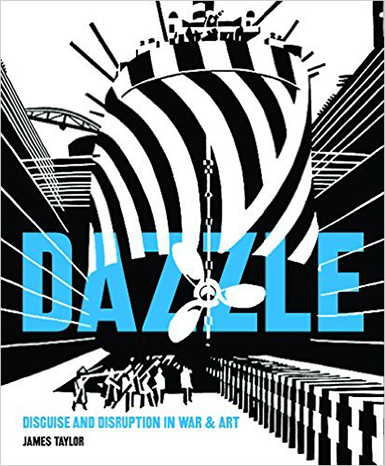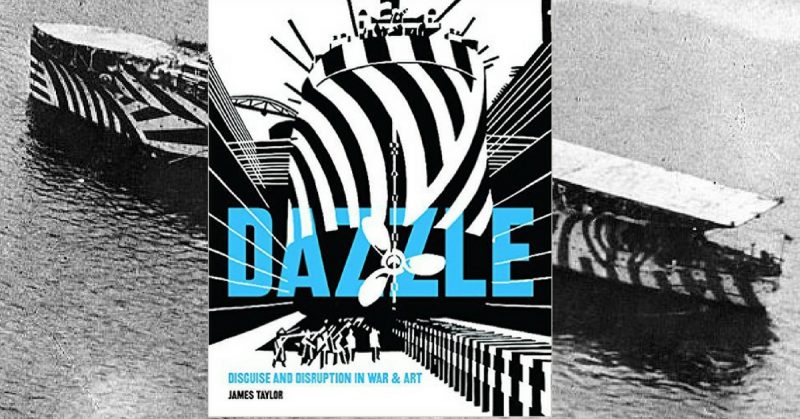You guys know me well enough by now to expect me to do this, so lets get it done: This book is dazzling from first to last. Ok, sorry about that, now allow me to get on with business.
This is superb book by James Taylor takes us through the history of Dazzle, the method of using colourful designs to alter the appearance and direction of a ship. The scheme was introduced during the second half of the Great War and was used to a limited degree during World War II when it was superseded by the convoy system. It aimed to distort the appearance of a ship when seen through a periscope in the fleeting moments a captain had to get the measure of his intended victim.
Dazzle wasn’t camouflage; on the contrary, it was meant to help make ships easier to see. But the colourful patterns could utterly confuse any submariner attempting to both identify the vessel and estimate its course and speed through a periscope. It was a kind of hiding in plain sight invention to literally dazzle the enemy. Despite limitations it appears to have worked in some situations, but not all naval types understood the methodology and some confused it with camouflage.
Mr Taylor explains all this in calm and patient tones and sets the scene for the concept really well. This may be a book about war at sea but it also about art and artists, revealing the receptiveness of key individuals to something as potentially daft as painting ships in bright colours where they would stand out on a grey background. The confusion Dazzle was intended to sow offered the briefest of windows of opportunity when, even in a time before sonar that came along a world war later, submarines were at considerable risk at periscope depth. Captains could not afford to hang about, so the Dazzle scheme was developed to hamper their hasty deliberations.
The clever man behind all this was the artist Norman Wilkinson, but while he was confirmed as the innovator of the scheme the British accepted, there were others looking at the same problems. Wilkinson was an artist and saw things largely in the terms of the medium. His chief rival for the claim of devising Dazzle was the scientist Professor J Graham Kerr, a man who would seek redress during and long after the war but who would ultimately be disappointed.
This wasn’t just a case of daubing any old colour in random ways. The schemes for each type of ship were worked out using scale models and even water tanks and periscopes to be most effective. A group of artists, often marine specialists with experience of the sea; were employed to oversee the application. Adherents of then new styles of modern art were also favoured. There was a degree of trial and error and it took time to get the schemes for each vessel right. The final results were often garish and incongruous in the extreme as photographic and artistic evidence reveals. An unintended aspect of Dazzle was the impact it had on sailors and merchant mariners whose morale was boosted by the appearance of such colourful vessels.
The scheme was taken up with enthusiasm in the United States where Wilkinson advised on how to implement it. He worked with many noted artists and seems to have been willing to exploit every opportunity for self-promotion and enrichment. Who can blame him?
Mr Taylor has produced a really fine history of an aspect to the war just about everyone has seen images of without understanding the actuality. Books like this embellish our understanding of events and introduce new people of interest. Because there is such a strong artistic element to the story the book is bound to appeal to people who are more interested in paint palettes than maritime warfare. Mr Taylor has merged very different worlds with due diligence so his book has considerable cross subject appeal. This is clever stuff. He brings it all up to date by looking at how Dazzle impacted on the worlds of art, fashion and design. Perhaps if you have a copy of Orchestral Manoeuvres in the Dark’s Dazzle Ships album in your LP collection you will be having one of those light bulb moments at this juncture.
I like this book. It fits well into the diverse world of military history I enjoy and the use of art and photo archive works brilliantly. This a complicated subject with plenty of sub plots that have been meshed into an effective and attractive book. It is something a bit different. Highly recommended.
Reviewed by Mark Barnes for War History Online.

DAZZLE
Disguise and Disruption in War and Art
By James Taylor
Pool of London
ISBN: 978 1 910860 14 4
